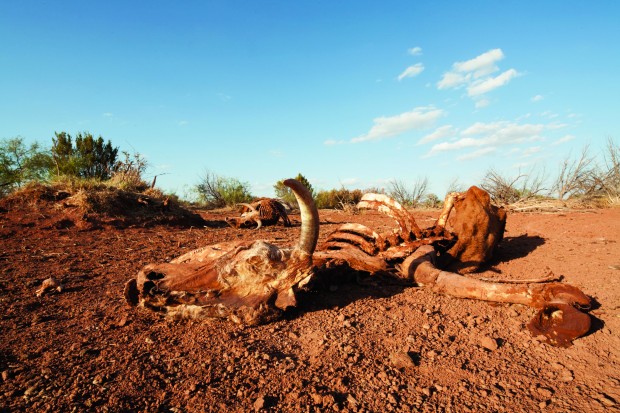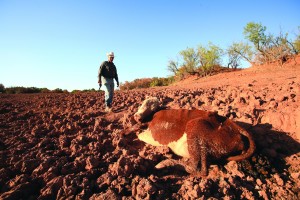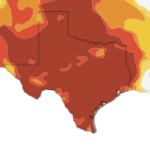Life By the Drop: Eyes of the Drought

Photo by Wyman Meinzer/Texas Monthly
The carcasses of two Hereford cows that perished on the Patterson Ranch.
 Wyman Meinzer, the state photographer of Texas, is used to finding beauty across the Lone Star State. But during the great drought, Meinzer was faced with the question of how to document devastation and destruction. In an interview with Jake Silverstein, editor of Texas Monthly, Meinzer talks about his work putting a lens to the drought.
Wyman Meinzer, the state photographer of Texas, is used to finding beauty across the Lone Star State. But during the great drought, Meinzer was faced with the question of how to document devastation and destruction. In an interview with Jake Silverstein, editor of Texas Monthly, Meinzer talks about his work putting a lens to the drought.
Q: Let’s talk about last year’s drought project. As someone raised in West Texas, you’ve lived through many droughts, including the 1950s drought when you were just a boy. When did you start to realize that last year’s drought was unusually bad?
A: Being an outdoorsman and a photographer not only are you a visual person, but also from my research background and my education as a biologist, you notice patterns. And I noticed in May and June things weren’t right. High winds. Just ever-present high winds, just incessant, wouldn’t end. Twenty, thirty, forty miles an hour. Temperatures way more than normal. And of course, being a person having been raised on a ranch, you notice water. You notice the availability, or [that] there is no water. You notice the stock tanks being almost dry and realizing that once you go into the summer months, the likelihood of a tank-filling rain, what we call a runoff rain, is very unlikely. So that’s when I started realizing that we were probably headed into a very serious situation and that I should document it.
Q: Is that the same moment you decided to go out and take pictures of the suffering that was going on?
A: Exactly. See, in the nineties we had sort of a mini-drought, and I worked pretty heavily in documenting that, but it was nothing like this one. I remembered the suffering then, I remembered back in the fifties the great dust storms that we used to have out there on the ranch. So I thought this is probably gonna be historical, and I need to document it photographically.

Photo by Wyman Meinzer/Texas Monthly
On the Patterson Ranch, a cow, paralyzed after a prolonged struggle to free itself from the mud, is about to be dispatched by Kynn Patterson.
Q: There’s one shot in particular that I want to ask you about. It shows a rancher approaching a cow that’s mired down in the mud and has been struggling so long that she’s paralyzed. The rancher has his gun drawn and his posture just kind of let’s you know what’s about to happen. What was that moment like?
A: That was very sad. I had seen the cow there. I had asked the rancher and he said, ‘yes, she had been there a couple times’. He had rescued her from the mud, but she kept coming back because there was no water in that part of the ranch. And he would try to go back every day. You would have to in these locations, where there is only one or two sources of stale water because everything would try to come back to drink, and almost everyday they would bog up and become mired in the mud. If they stayed out there over a day, maybe two days, it was a death sentence.
So he kept getting this cow out, but she kept going back. And finally she just struggled so much that apparently there was some nerve damage, and she became paralyzed, and she couldn’t straighten her neck. Her neck was folded back against her side. He just said, ‘there’s no use in her suffering any longer’, and so I said, ‘well, can I be there whenever you put her down?’ And he said, ‘sure.’
It was very sad to me. I mean it was heart-wrenching, but you do what you have to do. These men have been here a long time. Second, third, fourth generation cowmen, and this is just the way of life. This is the way it is in dire situations, in dire times like this drought of last summer.
Q: You must’ve sat and talked with a lot of ranchers like the one you just discussed. What are some of the things that they were going through?
A: They were very saddened by it. They felt sort of helpless. Obviously. I think that we could all agree to that. Even though they were experienced at the oscillations of weather conditions and seasons’ changes from all the years they’ve been here. This man is nearly seventy years old. This has been a family ranch since, gosh, his grandfather had it many years ago. Even though they expected this to occur, still there was pain. It was not something they just sort of passed off lightly. It was like, ‘You know, this is what’s gotta happen. I hate to lose them. I hate to see the suffering, but I have to do what I have to do’. If it meant killing the cattle … because they would try to get some of them. I knew of some cows that they would get out and take them in and try to feed them and water them, and many of them perished even though they were rescued.
Q: What did you mean by, ‘They expected it to happen’?
A: A lot of these ranches do not have water sources other than stock tanks. Some of them are lucky, and they have windmills. This particular ranch didn’t. Some of them, even the large ranches – this ranch was only 8,000 acres – but some of the big ranches don’t have any groundwater. They rely totally on stock tanks, and when the stock tanks start getting low, they know that this is coming. They try to haul water. A lot of them try to actually haul water daily into stock tubs. You have some parts of the ranch that’s very rough, very remote, and some of the cattle are very wild. Some of them are even afraid of manmade metal stock tanks, and they won’t even come in to drink. So they stay in the brush, they stay in these corners of the ranches, and they keep going back to these mud holes and eventually become mired up and trapped. The ranchers know that this is gonna happen. They try to frequent these areas as much as possible, but at times it’s beyond their capability to rescue them each and every time.
Q: What was the worst thing you saw out there?
A: Probably the most heart-rending sight that I saw was, one day I was on a place, and I rode up on a tank. There were several cattle carcasses that had perished, and they had already decayed. And I saw one in particular. This cow had been there, and she could hardly move. She was still alive. She was totally matted over. She looked like some prehistoric beast. And I walked up to her, and I was just heartbroken by what I saw. I just said – it was real funny, I spoke to her – I just said, ‘Oh, cow, I’m so sorry. I’m so sorry it has to be this way.’ She just sort of groaned. You couldn’t even see the eyes in her head. They had sunk so deeply in her skull. It was only cavities. And that broke my heart. That really broke my heart. I went and retrieved the Winchester, and I shot her between the eyes.
Q: Is there anything else on your mind about this experience or this project?
A: It was an education for me as well. As I mentioned earlier, I’ve not endured anything quite like this. Once I became immersed in it … you know, I’m one of these kind of people that if I get a project in my mind and I get involved, I go at it a thousand percent. I became really educated as to what the face of suffering, what the pain that these ranchers feel…
Although I don’t have a stock tank I worry about, although I don’t have cattle that I worry about, because of my upbringing on a ranch, you know, I feel like I’ve suffered the pain that these men and women did in the rolling plains of Texas. You know, the cattle, the horses, the people having to buy the exorbitant-priced feed, that pulled on me. And I told a rancher just the other day who was complaining that his tanks were still not full, and going into the summer season he needed the water. I said, ‘Man, I don’t have anything, any cattle, or horses, or stock tanks, but I feel your pain’, I said. ‘Because that’s part of my upbringing, and I wish I could help you, but the best I could do is take some photographs and bring to light what you’re going through’.

